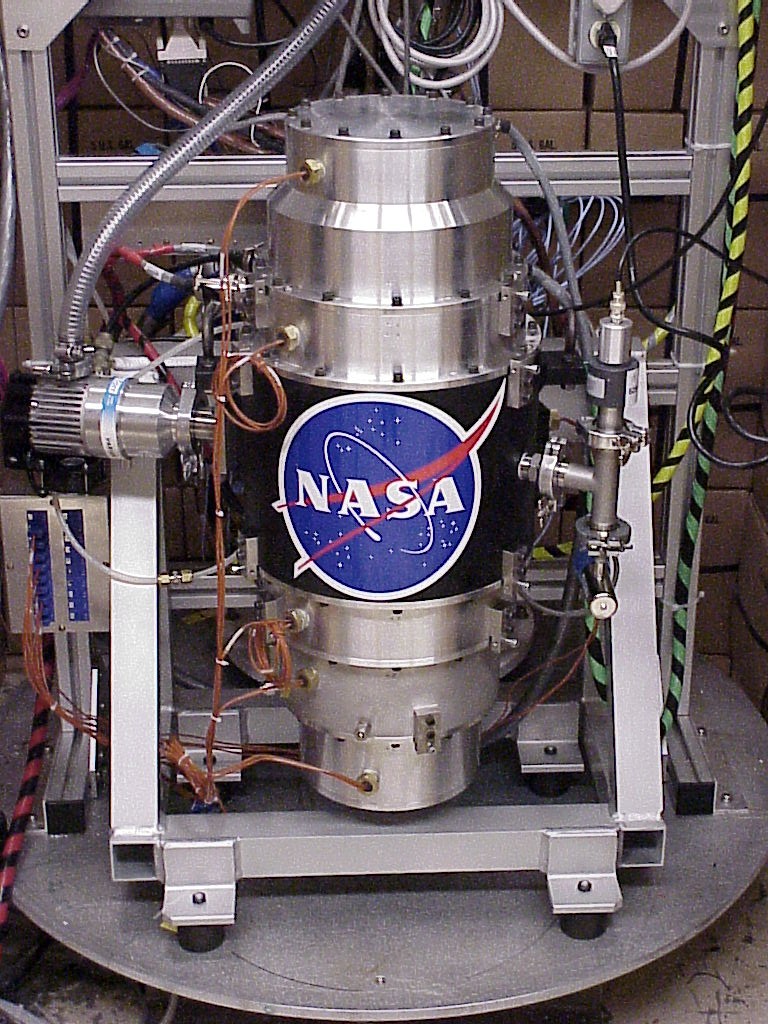|
Motor–generator
A motor–generator (an M–G set) is a device for converting electrical power to another form. Motor–generator sets are used to convert frequency, voltage, or phase of power. They may also be used to isolate electrical loads from the electrical power supply line. Large motor–generators were widely used to convert industrial amounts of power while smaller motor–generators (such as the one shown in the picture) were used to convert battery power to higher DC voltages. While a motor–generator set may consist of distinct motor and generator machines coupled together, a single unit dynamotor (for dynamo–motor) has the motor coils and the generator coils wound around a single rotor; both the motor and generator therefore share the same outer field coils or magnets.Radio Amateur's Handbook 1976, pub. |
Flywheel Energy Storage
Flywheel energy storage (FES) works by accelerating a rotor (flywheel) to a very high speed and maintaining the energy in the system as rotational energy. When energy is extracted from the system, the flywheel's rotational speed is reduced as a consequence of the principle of conservation of energy; adding energy to the system correspondingly results in an increase in the speed of the flywheel. Most FES systems use electricity to accelerate and decelerate the flywheel, but devices that directly use mechanical energy are being developed.Torotrak Toroidal variable drive CVT , retrieved June 7, 2007. Advanced FES systems have rotors made of high strength carbon-fiber composites, suspended by |
Engine-generator
An engine–generator is the combination of an electrical generator and an engine (prime mover) mounted together to form a single piece of equipment. This combination is also called an ''engine–generator set'' or a ''gen-set''. In many contexts, the engine is taken for granted and the combined unit is simply called a ''generator''. An engine–generator may be a fixed installation, part of a vehicle, or made small enough to be portable. Components In addition to the engine and generator, engine–generators generally include a fuel supply, a constant engine speed regulator (governor) and a generator voltage regulator, cooling and exhaust systems, and lubrication system. Units larger than about 1 kW rating often have a battery and electric starter motor; very large units may start with compressed air either to an air driven starter motor or introduced directly to the engine cylinders to initiate engine rotation. Standby power generating units often include an automatic start ... [...More Info...] [...Related Items...] OR: [Wikipedia] [Google] [Baidu] |
Torque
In physics and mechanics, torque is the rotational equivalent of linear force. It is also referred to as the moment of force (also abbreviated to moment). It represents the capability of a force to produce change in the rotational motion of the body. The concept originated with the studies by Archimedes of the usage of levers, which is reflected in his famous quote: "''Give me a lever and a place to stand and I will move the Earth''". Just as a linear force is a push or a pull, a torque can be thought of as a twist to an object around a specific axis. Torque is defined as the product of the magnitude of the perpendicular component of the force and the distance of the line of action of a force from the point around which it is being determined. The law of conservation of energy can also be used to understand torque. The symbol for torque is typically \boldsymbol\tau, the lowercase Greek letter ''tau''. When being referred to as moment of force, it is commonly denoted by . In ... [...More Info...] [...Related Items...] OR: [Wikipedia] [Google] [Baidu] |
Electromagnetic Aircraft Launch System
The Electromagnetic Aircraft Launch System (EMALS) is a type of aircraft launching system developed by General Atomics for the United States Navy. The system launches carrier-based aircraft by means of a catapult employing a linear induction motor rather than the conventional steam piston. EMALS was first installed on the lead ship of the , the USS ''Gerald R. Ford''. Its main advantage is that it accelerates aircraft more smoothly, putting less stress on their airframes. Compared to steam catapults, the EMALS also weighs less, is expected to cost less and require less maintenance, and can launch both heavier and lighter aircraft than a steam piston-driven system. It also reduces the carrier's requirement of fresh water, thus reducing the demand for energy-intensive desalination. Design and development Developed in the 1950s, steam catapults have proven exceptionally reliable. Carriers equipped with four steam catapults have been able to use at least one of them 99.5% of t ... [...More Info...] [...Related Items...] OR: [Wikipedia] [Google] [Baidu] |
Brake
A brake is a mechanical device that inhibits motion by absorbing energy from a moving system. It is used for slowing or stopping a moving vehicle, wheel, axle, or to prevent its motion, most often accomplished by means of friction. Background Most brakes commonly use friction between two surfaces pressed together to convert the kinetic energy of the moving object into heat, though other methods of energy conversion may be employed. For example, regenerative braking converts much of the energy to electrical energy, which may be stored for later use. Other methods convert kinetic energy into potential energy in such stored forms as pressurized air or pressurized oil. Eddy current brakes use magnetic fields to convert kinetic energy into electric current in the brake disc, fin, or rail, which is converted into heat. Still other braking methods even transform kinetic energy into different forms, for example by transferring the energy to a rotating flywheel. Brakes are generally ... [...More Info...] [...Related Items...] OR: [Wikipedia] [Google] [Baidu] |
Flywheel
A flywheel is a mechanical device which uses the conservation of angular momentum to store rotational energy; a form of kinetic energy proportional to the product of its moment of inertia and the square of its rotational speed. In particular, assuming the flywheel's moment of inertia is constant (i.e., a flywheel with fixed mass and second moment of area revolving about some fixed axis) then the stored (rotational) energy is directly associated with the square of its rotational speed. Since a flywheel serves to store mechanical energy for later use, it is natural to consider it as a kinetic energy analogue of an electrical inductor. Once suitably abstracted, this shared principle of energy storage is described in the generalized concept of an accumulator. As with other types of accumulators, a flywheel inherently smooths sufficiently small deviations in the power output of a system, thereby effectively playing the role of a low-pass filter with respect to the mechanical velocity ... [...More Info...] [...Related Items...] OR: [Wikipedia] [Google] [Baidu] |
Rutherford Appleton Laboratory
The Rutherford Appleton Laboratory (RAL) is one of the national scientific research laboratories in the UK operated by the Science and Technology Facilities Council (STFC). It began as the Rutherford High Energy Laboratory, merged with the Atlas Computer Laboratory in 1975 to create the Rutherford Lab; then in 1979 with the Appleton Laboratory to form the current laboratory. It is located on the Harwell Science and Innovation Campus at Chilton near Didcot in Oxfordshire, United Kingdom. It has a staff of approximately 1,200 people who support the work of over 10,000 scientists and engineers, chiefly from the university research community. The laboratory's programme is designed to deliver trained manpower and economic growth for the UK as the result of achievements in science. History RAL is named after the physicists Ernest Rutherford and Edward Appleton. The National Institute for Research in Nuclear Science (NIRNS) was formed in 1957 to operate the Rutherford High Energy La ... [...More Info...] [...Related Items...] OR: [Wikipedia] [Google] [Baidu] |
Nimrod (synchrotron)
Nimrod (National Institute Machine Radiating on Downs, "the Mighty Hunter" Nimrod; name attributed to W. Galbraith) was a 7 GeV proton synchrotron operating in the Rutherford Appleton Laboratory in the United Kingdom between 1964 and 1978. Nimrod delivered its last particles at 17:00 hrs on 6 June 1978. Although roughly contemporary with the CERN PS its conservative design used the "weak focussing" principle instead of the much more cost-effective "strong-focussing" technique, which would have enabled a machine of the same cost to reach much higher energies. The design and construction of Nimrod was carried out at a capital cost of approximately £11 million. It was used for studies of nuclear and sub-nuclear phenomena. Nimrod was dismantled and the space it occupied reused for the synchrotron of the ISIS neutron source The ISIS Neutron and Muon Source is a pulsed neutron and muon source, established 1984 at the Rutherford Appleton Laboratory of the Science and Techn ... [...More Info...] [...Related Items...] OR: [Wikipedia] [Google] [Baidu] |
Princeton Plasma Physics Laboratory
Princeton Plasma Physics Laboratory (PPPL) is a United States Department of Energy national laboratory for plasma physics and nuclear fusion science. Its primary mission is research into and development of fusion as an energy source. It is known in particular for the development of the stellarator and tokamak designs, along with numerous fundamental advances in plasma physics and the exploration of many other plasma confinement concepts. PPPL grew out of the top-secret Cold War project to control thermonuclear reactions, called Project Matterhorn. The focus of this program changed from H-bombs to fusion power in 1951, when Lyman Spitzer developed the stellarator concept and was granted funding from the Atomic Energy Commission to study the concept. This led to a series of machines in the 1950s and 60s. In 1961, after declassification, Project Matterhorn was renamed the Princeton Plasma Physics Laboratory. PPPL's stellarators proved unable to meet their performance goals. In 196 ... [...More Info...] [...Related Items...] OR: [Wikipedia] [Google] [Baidu] |
Princeton Large Torus
The Princeton Large Torus (or PLT), was an early tokamak built at the Princeton Plasma Physics Laboratory (PPPL). It was one of the first large scale tokamak machines, and among the most powerful in terms of current and magnetic fields. Originally built to demonstrate that larger devices would have better confinement times, it was later modified to perform heating of the plasma fuel, a requirement of any practical fusion power device. The tokamak became a topic of serious discussion in 1968, when the Soviets published new data showing them to be far and away better than any other fusion device. This generated significant scepticism among other researchers and took some time before the PPPL was convinced to convert their Model C stellarator to the tokamak configuration. It immediately validated the Soviet results and then surpassed them. The next step in developing the system would be to build a larger machine in order to test whether the confinement time of the plasma ''scaled'' ... [...More Info...] [...Related Items...] OR: [Wikipedia] [Google] [Baidu] |
General Atomics
General Atomics is an American energy and defense corporation headquartered in San Diego, California, specializing in research and technology development. This includes physics research in support of nuclear fission and nuclear fusion energy. The company also provides research and manufacturing services for remotely operated surveillance aircraft, including the General Atomics MQ-1 Predator, Predator drones, airborne sensors, and advanced electric, electronic, wireless, and laser technologies. History General Atomics (GA) was founded on July 18, 1955, in San Diego San Diego ( , ; ) is a city on the Pacific Ocean coast of Southern California located immediately adjacent to the Mexico–United States border. With a 2020 population of 1,386,932, it is the List of United States cities by population, eigh ..., California, by Frederic de Hoffmann with assistance from notable physicists Edward Teller and Freeman Dyson. Originally the company was part of the General Atomic divi ... [...More Info...] [...Related Items...] OR: [Wikipedia] [Google] [Baidu] |




.jpg)
